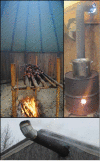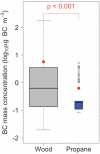Wood smoke black carbon from Indigenous traditional cultural activities in a subarctic Cree community
- PMID: 32835644
- PMCID: PMC7480623
- DOI: 10.1080/22423982.2020.1811517
Wood smoke black carbon from Indigenous traditional cultural activities in a subarctic Cree community
Abstract
Indoor concentrations of black carbon (BC) were measured when wood was burned for traditional cultural activities in a study in a Cree community located in subarctic Canada. The study also included an intervention using a propane-fuelled heater to mitigate in situ BC. Mass concentrations of BC were measured in a game-smoking tent for 39 days and in hunting cabins on the west coast of James Bay, Canada, for 8 days. Five-minute averaged BC mass concentration (N = 12,319) data were recorded and assessed using optimised noise-reduction averaging. Mean BC mass concentrations were lower in hunting cabins (mean = 8.25 micrograms per cubic metre (µg m-3)) and higher in the game-smoking tent (mean = 15.46 µg m-3). However, excessive BC peaks were recorded in the game-smoking tent (maximum = 3076.71 µg m-3) when the fire was stoked or loaded. The intervention with the propane heater in a hunting cabin yielded a 90% reduction in measured BC mass concentrations. We do not presume that exposure to BC is of concern in hunting cabins with appropriate wood-burning appliances that are well-sealed and vent outside. In game-smoking tents, we advise that persons take intermittent breaks outside of the tent for fresh air.
Keywords: Cree; Indigenous; James Bay; Wood; black carbon; indoors; smoke.
Conflict of interest statement
The authors report no conflict of interest.
Figures






References
-
- Champion WM, Charley PH, Klein B, et al. Perception, culture, and science: a framework to identify in-home heating options to improve indoor air quality in the Navajo Nation. Sci Total Environ. 2017;580:297–13. - PubMed
-
- Pal S, Haman F, Robidoux MA.. The costs of local food procurement in two Northern Indigenous communities in Canada. Food Foodways. 2013;21:132–152.
-
- Martin WJ, Hollingsworth JW, Ramanathan V.. Household air pollution from cookstoves: impacts on health and climate. In: Pinkerton KE, Rom WN, editors. Global climate change and public health [Internet]. New York: Springer New York; 2014. 237–255. [cited 2019 December9]. Available from: http://link.springer.com/10.1007/978-1-4614-8417-2_13 - DOI
-
- Balmes JR. Indoor biomass burning and health consequences. In: Nadadur SS, Hollingsworth JW, editors. Air pollut health eff [Internet]. London: Springer London; 2015. 381–402. [cited 2019 December9]. Available from: http://link.springer.com/10.1007/978-1-4471-6669-6_14 - DOI
Publication types
MeSH terms
Substances
Grants and funding
LinkOut - more resources
Full Text Sources
Medical
